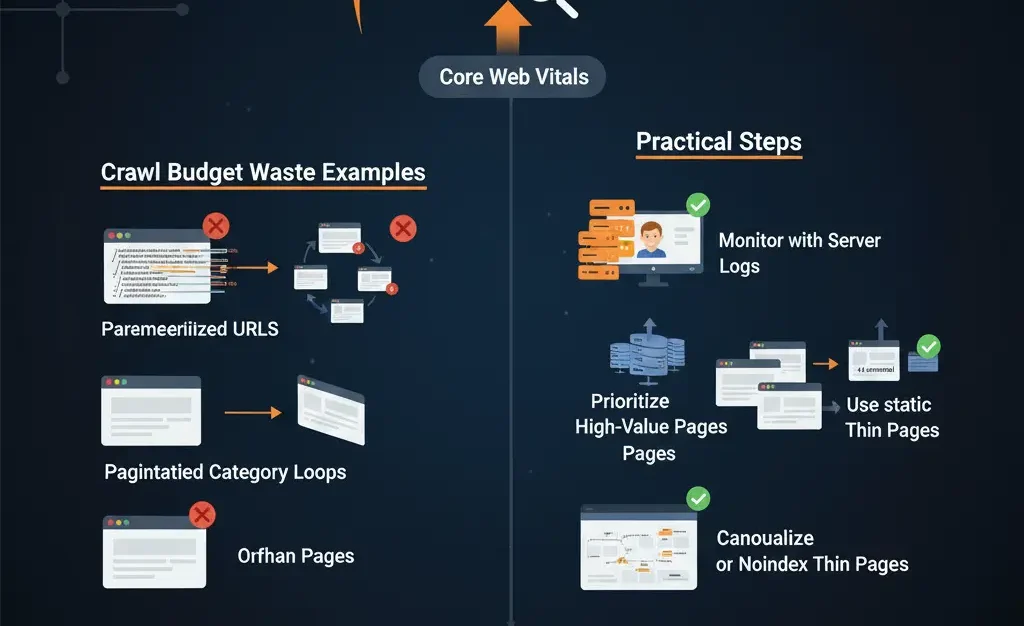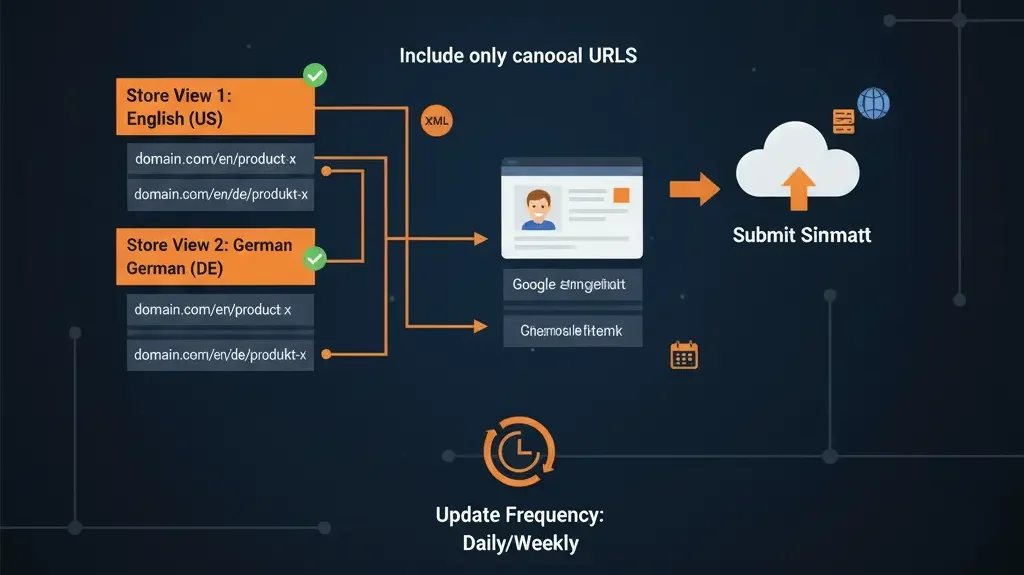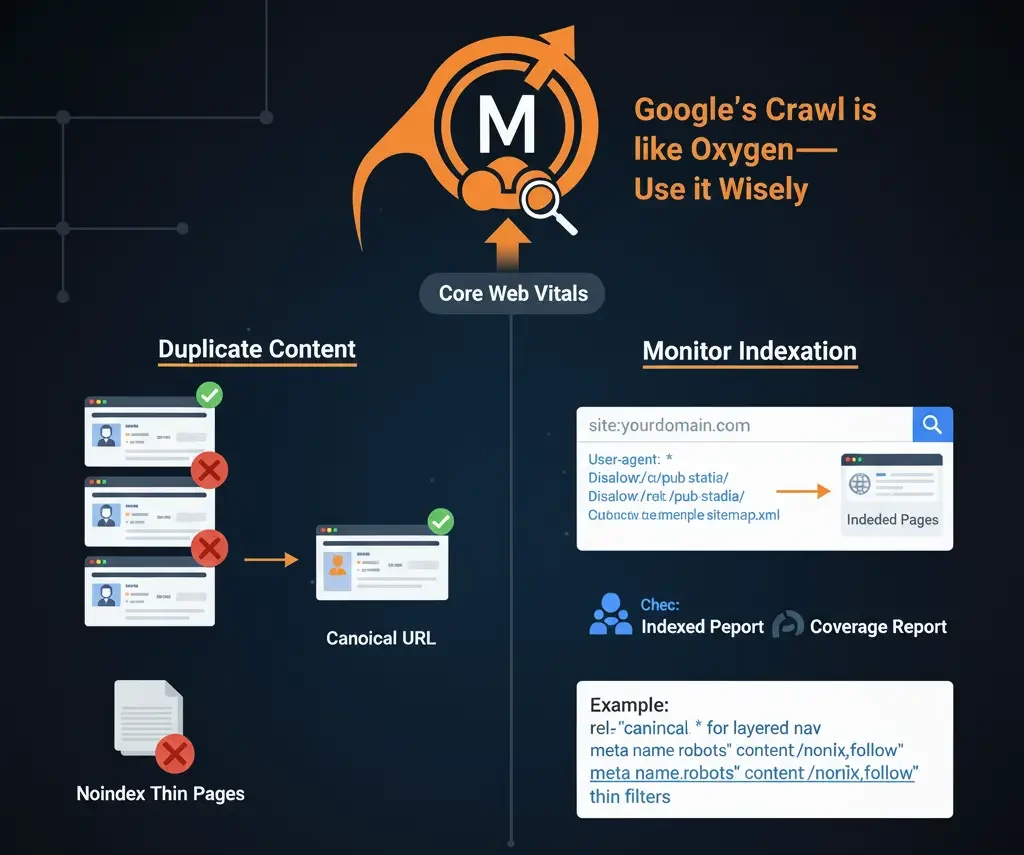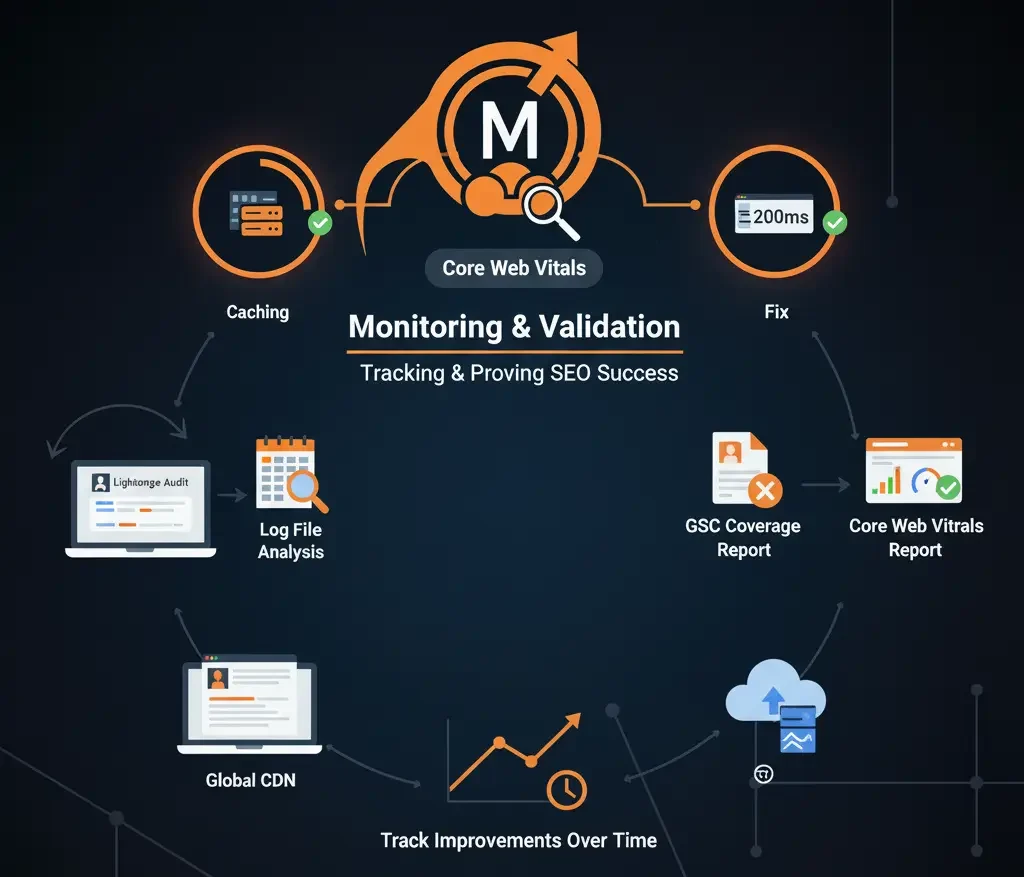Every great Magento 2 store is built on design, products, and storytelling – but none of it matters if Google can’t see it.
That’s where technical SEO becomes your silent powerhouse. It’s not glamorous, but it’s the difference between a store that exists and a store that performs.
From how fast your pages load to how efficiently they’re crawled and indexed, every technical choice shapes your visibility.
Think of it as your digital infrastructure – invisible to customers, yet vital to every conversion. Because in the world of search, one truth never changes:
A store can’t convert what Google can’t crawl.
Understanding Core Web Vitals for Magento 2

When it comes to performance, Core Web Vitals are Google’s way of measuring how real users experience your Magento 2 store. They don’t care about fancy themes or plugins but about speed, stability, and responsiveness.
If your pages load slowly or shift around while users interact, Google interprets that as frustration, not quality.
This is where Magento 2’s caching systems (Redis, Varnish) and CDN integrations (Cloudflare, Fastly) make all the difference. They reduce server load, deliver content globally, and transform sluggish pages into smooth, trustworthy experiences.
Core Web Vitals Benchmarks
Metric | Good | Needs Improvement | Poor | Fix |
LCP (Largest Contentful Paint) | < 2.5s | 2.5–4.0s | > 4.0s | Optimize hero images, caching, lazy-load media |
CLS (Cumulative Layout Shift) | < 0.1 | 0.1–0.25 | > 0.25 | Use static image dimensions, preload fonts |
INP (Interaction to Next Paint) | < 200ms | 200–500ms | > 500ms | Reduce JavaScript execution, use async loading |
Each millisecond saved boosts trust, conversions, and rankings. When your Magento 2 store feels instant and stable, Google sees it as user-first design, not just code efficiency. Because online, speed isn’t cosmetic – it’s confidence.
Crawl Budget Optimization

Every Magento 2 store has a crawl budget – a kind of oxygen supply for your website. Googlebot breathes through your pages, deciding how much energy it will spend crawling, indexing, and understanding your site. Use that oxygen wisely.
When your crawl budget is wasted, Google spends time exploring things that don’t matter – parameterized URLs, endless pagination loops, and orphan pages that lead nowhere.
The result? Important products stay invisible while duplicates eat your crawl energy.
Crawl Budget Wastage Examples
Problem | Example | Fix |
Parameterized URLs | /mens-shoes?color=black | Canonicalize to main category URL |
Paginated loops | /mens-shoes?page=3&sort=price | Add rel=”next/prev” or consolidate pages |
Orphan pages | Unlinked seasonal product pages | Reconnect via internal links or XML sitemap |
Practical Optimization Steps
- Monitor with server logs to see how Googlebot actually crawls your store.
- Prioritize high-value pages – category hubs, best-sellers, and informational guides.
- Canonicalize or noindex thin, filtered, or parameter-heavy URLs.
- Submit clean XML sitemaps that guide bots directly to what matters.
Key Takeaway
Your goal isn’t to make Google crawl everything – it’s to make it crawl the right things. When your internal linking, sitemap, and canonical signals work in harmony, your crawl budget becomes a precision tool – fueling the pages that earn visibility and trust.
XML Sitemap Configuration in Magento 2

Think of your XML sitemap as your Magento 2 store’s navigation beacon – the digital map that guides Googlebot straight to your most valuable pages.
Without it, even the most beautiful product catalog can drift unseen in the depths of the web.
A well-built sitemap tells search engines exactly what to crawl and how often to return. It’s not just about inclusion – it’s about direction and priority.
How to Build a Healthy Sitemap in Magento 2
Step | Action | Why It Matters |
1. One sitemap per store view | Generate individual sitemaps for each language or storefront. | Keeps URLs organized by context and audience. |
2. Include only canonical URLs | Exclude duplicates, filters, or test environments. | Ensures Google indexes the right entities. |
3. Set update frequency | Daily for dynamic catalogs, weekly for stable sites. | Signals freshness and ongoing activity. |
4. Submit via Google Search Console → Sitemaps | Use the live sitemap URL. | Confirms discovery and monitors indexing status. |
A clean, logical XML sitemap turns your Magento 2 store from a maze into a map.
When Google knows where to go – and why each page matters – indexation becomes not just faster, but smarter.
robots.txt: Directing the Bots
Every thriving Magento 2 store needs a bouncer at the door – someone who decides who gets in and who doesn’t.
That’s exactly what your robots.txt file does. It controls how search engines crawl your site, protecting sensitive pages and steering bots toward the ones that matter.
A well-configured robots.txt isn’t about blocking Google; it’s about guiding it – keeping crawlers focused on your products, categories, and content while shutting out the noise from cart pages, filters, and internal searches.
Smart Rules for Magento 2 robots.txt
Goal | Directive | Why It Matters |
Block sensitive pages | Disallow: /checkout/ Disallow: /customer/ | Prevents indexing of private user paths |
Skip internal searches & filters | Disallow: /search/ | Avoids crawl waste from infinite query loops |
Allow design assets | Allow: /pub/static/ | Ensures proper rendering for Googlebot |
Reference sitemap | Sitemap: https://www.example.com/sitemap.xml | Connects your crawl rules with your sitemap |
Example Magento 2 robots.txt Configuration
User-agent: *
Disallow: /checkout/
Disallow: /customer/
Disallow: /search/
Allow: /pub/static/
Sitemap: https://www.example.com/sitemap.xml
Optimization Tips
- Allow essential JS & CSS – Google needs them to render your pages accurately.
- Block parameter-heavy URLs that create duplicate content.
- Test your file using Google Search Console → Robots Testing Tool before deploying.
- Monitor crawl stats – a sudden spike or drop could signal misconfiguration.
Your robots.txt file may be only a few lines of text, but it has the power to shape how Google understands your entire Magento 2 store.
Used wisely, it doesn’t restrict your visibility – it sharpens it, ensuring every crawl counts toward the pages that actually build authority.
Indexation Management & Canonicalization

Indexation isn’t just about getting your Magento 2 pages into Google – it’s about making sure the right pages show up.
Every duplicate, filter, or thin page dilutes your authority. That’s where canonical tags and noindex directives become your best allies.
Use canonicals to unify layered navigation pages and parameter variants under one true URL.
Mark tag pages or filters as noindex – they don’t deserve your crawl budget.
And always double-check your footprint with a quick site:yourdomain.com search or the GSC Coverage report.
Because smart indexation isn’t volume – it’s clarity.
Google doesn’t just need to find you; it needs to understand which version of you matters most.
Performance Optimization Layer

Speed isn’t just technical – it’s emotional.
When your Magento 2 store loads fast, users feel it instantly. Every click, every scroll, every product preview becomes effortless. That’s not just convenience – it’s trust.
Start with Redis and Varnish caching to shave seconds off server response times. Add a global CDN like Cloudflare or Fastly to deliver your store anywhere in the world in under 200ms.
Then polish the experience: convert images to WebP, enable lazy loading, and bundle your JS efficiently.
Finally, test your masterpiece in PageSpeed Insights or Lighthouse – not just for a score, but to measure how your performance feels.
Because in eCommerce, speed isn’t decoration – it’s persuasion.
Monitoring & Validation
Optimization without validation is like driving blindfolded – fast, but risky. That’s why technical monitoring is the heartbeat of your Magento 2 SEO.
Run weekly Lighthouse audits to track Core Web Vitals and discover render-blocking issues before Google does.
Dive into server log files to see how bots actually crawl your site – not how you hope they do.
Use Google Search Console for Coverage and Core Web Vitals reports, and Sitebulb or Screaming Frog for in-depth crawling and indexation mapping.
Review. Adjust. Repeat.
When you track progress over time, every technical tweak tells a story – one where your store gets faster, cleaner, and more visible, week after week.
Magento 2 Technical SEO Checklist (Summary Table)
Think of this as your monthly health check for your Magento 2 store – a routine that keeps your technical SEO sharp, efficient, and fully aligned with Google’s understanding of your site.
Each line here is a signal – when they all work together, your store moves from just “crawlable” to credible.
Area | Task | Tool | Frequency | Entity Reinforced |
Core Web Vitals | Audit LCP, CLS, INP for performance | PageSpeed Insights / Lighthouse | Weekly | Performance |
Crawl Budget | Review logs, fix orphan pages | Sitebulb / Log File Analyzer | Monthly | Crawl Efficiency |
XML Sitemap | Validate sitemap structure & indexation | Google Search Console / Screaming Frog | Monthly | Discovery |
robots.txt | Check disallowed paths, test rendering | Manual / GSC Robots Tester | Quarterly | Access Control |
Canonicals | Audit duplicate content and signals | Ahrefs / Screaming Frog | Quarterly | Entity Clarity |
Treat this checklist like a living document – not a one-time setup. Every audit teaches Google a little more about who you are and how your Magento 2 store deserves to be understood.
Keep refining, testing, and validating – because technical excellence isn’t a task list… it’s a mindset.
Conclusion
Magento 2 rewards brands that think like engineers and communicate like experts. Technical SEO isn’t a checklist – it’s an ongoing dialogue between your store, your server, and Google’s understanding of both.
Every sitemap you refine, every crawl path you fix, every millisecond you save is a message – a signal of trust, clarity, and expertise. When performance meets meaning, Google doesn’t just crawl your site; it recognizes it.
So, build with precision. Audit with intent.
And remember – true visibility isn’t earned through hacks or haste. It’s crafted through a system that runs as intelligently as the people behind it.



